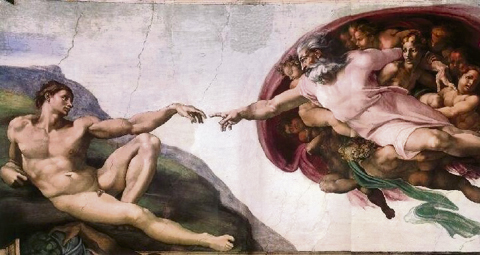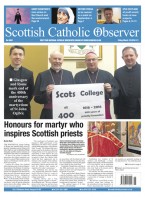January 15 | ![]() 0 COMMENTS
0 COMMENTS ![]() print
print

Should the Pope sell the treasure of the Vatican?
St Andrews' Catholic Society member SARA CHAN looks at this controversial issue for the Scottish Network of Catholic Students in this month’s FAITH BY DEGREES article in the SCO
On November 17 2015 St Andrews University Union Debating Society gathered to debate the following motion: that This House believes that the Pope should sell the treasures of the Vatican. For the proposition were Alasdair Edwards, humanist contact for the University Chaplaincy, Sarah Bliss, a second year undergraduate student reading for an MA in Arabic, and Euan Grant, a postgraduate reading for a PhD in divinity. Opposing the motion were John Deighan, chief executive of SPUC Scotland and former director of the Catholic Church’s Parliamentary Office in Scotland, the Reverend Dr Donald McEwan, the University Chaplain, and Francois Sarah, postgraduate reading for a PhD in International relations.
The ‘treasures of the Vatican,’of course, refer to the vast artistic and historical collections held by the Holy See in the Vatican City complex that include famous pieces such as Michelangelo’s Pieta and the frescoes of Creation and the Last Judgment which adorn the Sistine Chapel (above). The Vatican library houses treasures of another sort: founded by Pope Nicholas V in 1450, it contains over a million volumes, medieval manuscripts and the world’s oldest known complete Bible, which is believed to have been commissioned by the Roman Emperor Constantine in the 4th century. Mr Edwards opened the debate by contrasting the beauty and transcendent splendour of the treasures with the harsh reality of the creeping poverty that presses close even to the steps of the Roman Basilicas. Should the Pope sell these treasures, so the old argument goes, he would immediately acquire an immense amount of wealth that could be used to aid the poor.
The Sistine Chapel, it was observed, has already been rented out for private functions, thus setting a precedent for commercialising the Vatican’s treasures for the financial wherewithal to do good. Next, Miss Bliss argued that the treasures of the Vatican represent the artistic heritage of all Western peoples, and are not the sole property of the Catholic Church. Although entry to the Vatican museums currently cost only 8 euros, many may be unable to afford the journey to Rome. To ensure greater accessibility, therefore, Miss Bliss proposed, not unreasonably, that the treasures of the Vatican be distributed and circulated in museums throughout the world. Miss Bliss was also concerned with the limited accessibility of the documents in the Vatican library. In particular, her own recent attempt to access them was denied because she lacked the proper credentials, which she interpreted as suspicious concealment of information.
Finally, Mr Grant wrapped up the proposition’s case by proposing that it would actually be in the Church’s own spiritual interests to sell the treasures, since the possession of material treasures might be unconducive to the pursuit of a pure spiritual life. While he maintains that treasures such as chalices, candlesticks and basilicas ought to remain because of their direct use in worship, the possession of purely artistic pieces distract the Pope and cardinals from living the life of poverty that Jesus did.
In opposition to the motion, backed by St Andrews’ Catholic Society, Mr Deighan pointed out that the Vatican already does much, indeed much more than any other non-governmental organisation in the world, to alleviate the suffering of the global poor, thus challenging the picture suggested by Mr Edwards of Vatican officials resplendent within their palaces while Lazarus starves at their gates. Dr McEwan introduced another dimension to the debate by raising the question of who would purchase the Vatican’s treasures should the Pope be inclined to sell them. According to Dr McEwan, no public body could afford to purchase these treasures, and if they did, the financial power would be a direct result of increased taxes, which the poor, whom the selling of the Vatican’s treasures is supposed to benefit, can ill-afford. Meanwhile, should the treasures fall into the hands of private collectors, it is more than likely that only a select few would henceforth be able to enjoy the artistic heritage of all western peoples. On the other hand, should the treasures be bought by a private corporation, driven by financial gain, it is most likely that the treasures would be available to view only at increasingly exorbitant prices. The best option therefore, is that the treasures remain with the Vatican, accessible for the less than the average price of a lunch in one of Europe’s busiest metropolises.
Finally, Mr Sarah claimed that the beauty of the treasures has a transcendent effect and may raise the mind above the commonalities of life. Through them, man may be brought closer to contemplation of the beautiful and eternal, that is, closer to contemplation of God. A lively discussion among the audience ensued, touching on various aspects from whether the British monarchy is, like Pope Francis, morally obligated to sell their treasures, to the reminder that archaeological evidence suggests that artefacts in private hands do not tend to survive the centuries, to a discussion of whether Pope Francis has a particular duty as a Jesuit to embrace poverty.
The night closed with a vote: 40-19 in favour of the opposition—the motion did not stand. Just at the beginning of the busy, noisy, and heavily commercialised Christmas season, and now reflecting on it shortly after it has passed, it was reassuring to learn that two thirds of the young people who heard the debate agree with us, that sometimes value, beauty and splendour simply can and should not only be appreciated in crude financial terms.
—What do you think about this new monthly section in the SCO? Have your say on the Scottish Network of Catholic Students Facebook page at https://www. facebook.com/scotncs











